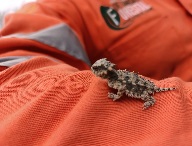 |
Coast Horned Lizard Range Map
|
|
|
 |
 |
 |
 |
 |
 |
 |
Coast Horned Lizard Video
|
|
|
 |
 |
 |
 |
 |
 |
 |
Coast Horned Lizard Juvenile

|
|
|
 |
 |
 |
 |
 |
 |
|
Coast Horned Lizard (Phrynosoma coronatum)
Description: The coast horned lizard appears rough and spiky but is actually smooth-skinned, although it has sharp spikes along its sides, back and head. It is a large species, and can reach 4 inches excluding the tail. It is less rounded than other horned lizards. It has two large dark blotches behind its head, followed by three broad bands on its body, with several smaller bands along the tail. Its colour can be various shades of brown, with cream 'accents' around the blotches and the outer fringe of its scales.
Habitat: This lizard occurs in a variety of habitats, including scrubland, grassland, coniferous woods, and broadleaf woodlands. Typically it is found in areas with sandy soil, scattered shrubs, and ant colonies, such as along the edges of arroyo bottoms or dirt roads. In southern California, P. coronatum was most common in areas with native ants and few or no Argentine ants, in areas with native chaparral vegetation, and in sites with porous soils relatively free of organic debris. Individuals bury themselves in loose soil. Eggs are laid in a nest dug in the soil or in a burrow.
Range: This lizard ranges throughout most of west-central and southwestern California (United States) as well as most of Baja California (Mexico) (except the northeastern portion). In California, it ranges north to Shasta County, though a disjunct population occurs farther north at Grasshopper Flat, Siskiyou County, California. The elevational range extends from near sea level to around 8,000 feet. Attempted introductions at Yosemite Valley and San Clemente Island (California), and in Hawaii, Colombia, and Guatemala have failed.
Found in these States:
CA
Diet: More than 90% of the Coast Horned Lizardís diet consists of ants, particularly native harvester ants. It is imperative that its habitats also support a healthy population of native harvester ants. A significant threat to the Coast Horned Lizardís diet is the invasive Argentine ants. As the Horned Lizardsí habitats are developed, it brings the Argentine ants. The Argentine ants displace the native ants that are almost the entirety of Horned Lizardsí food source. Studies have shown that Horned Lizards that fed on Argentine ants showed decreased or no growth compared to Horned Lizards that fed on native harvester ants.
Status: Listed as Least Concern in view of its wide distribution, tolerance of a broad range of habitats, presumed large population, and because it is unlikely to be declining fast enough to qualify for listing in a threatened category.
»» Kingdom: Animalia - Animals
»» Phylum: Chordata - Chordates
»» Subphylum: Vertebrata - Vertebrates
»» Class: Reptilia - Reptiles
»» Order: Squamata - Lizards
»» Family: Phrynosomatidae - North American Spiny Lizards
»» Genus: Phrynosoma
»» Species: Phrynosoma coronatum - Coast Horned Lizard
»» Subspecies: None
This article uses material from the Wikipedia article "Coast Horned Lizard", which is released under the Creative Commons Attribution-Share-Alike License 3.0. Content may have been omitted from the original, but no content has been changed or extended.
|
|







